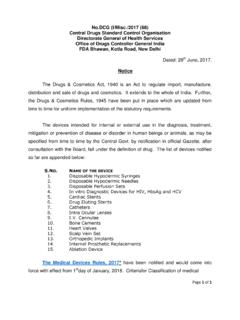Transcription of Policy Brief - World Health Organization
1 Policy BriefDay surgery : making it HappenbyCarlo CastoroLuigi BertinatoUgo BaccagliniChristina A. DraceMartin McKeewith the collaboration of IAASE xecutive Committee MembersInternational Associationfor Ambulatory surgery World Health Organization 2007,on behalf of the EuropeanObservatory on Health Systems and PoliciesAll rights reserved. The EuropeanObservatory on Health Systems and Policies welcomes requests forpermission to reproduce or translateits publications, in part or in full (seeaddress on inside back cover).The views expressed by authors or editors do notnecessarily represent the decisions or the stated policies of the European Observatory on HealthSystems and Policies or any of its partners. The designations employed and the presentation of the material in this Policy Brief do not imply theexpression of any opinion whatsoever on the part ofthe European Observatory on Health Systems andPolicies or any of its partners concerning the legalstatus of any country, territory, city or area or of itsauthorities, or concerning the delimitation of its frontiers or boundaries.
2 Where the designation country or area appears in the headings of tables,it covers countries, territories, cities, or areas. Dottedlines on maps represent approximate border lines forwhich there may not yet be full mention of specific companies or of certain manufacturers products does not imply that they are endorsed or recommended by the EuropeanObservatory on Health Systems and Policies in preference to others of a similar nature that are not mentioned. Errors and omissions excepted, thenames of proprietary products are distinguished byinitial capital European Observatory on Health Systems and Policies does not warrant that the informationcontained in this Policy Brief is complete and correctand shall not be liable for any damages incurred asa result of its Association for AmbulatorySurgeryThe International Association for AmbulatorySurgery (IAAS) is dedicated to the globalexchange of information and advancement of ambulatory surgery , encouraging the development and expansion of high-qualityambulatory surgery across the World .
3 It actsas an advisory body for the development andmaintenance of high standards of patient carein ambulatory surgery committee members:Ugo Baccaglini (Italy)Dick De Jong (Netherlands)Claus Toftgaard (Denmark)Paul Baskerville (United Kingdom)Carlo Castoro (Italy)Raafat S. Hannallah (United States)Paul Jarrett (United Kingdom)Paulo Lemos (Portugal)G rard Parmentier (France)Jacky Reydelet (Germany)Lindsay Roberts (Australia)Andrzej Staniszewski (Poland)Paul Vercruysse (Belgium)Robert C. Williams (United States)About the authors:Carlo Castorois Consultant Surgeon at theIstituto Oncologico Veneto (IOV-IRCCS),Department of Medical and SurgicalSciences, University of Padova School ofMedicine, Italy. Luigi Bertinatois Director of the InternationalHealth & Social Affairs Office, Veneto Region,Venice, ItalyUgo Baccagliniis President of the InternationalAssociation for Ambulatory surgery , DaySurgery Unit, Padova University Hospital, Italy. Christina A. Draceis a scientific communicationconsultant, Padova, Italy.
4 Martin McKeeis Professor of European PublicHealth at the London School of Hygiene &Tropical Medicine, and Research Director atthe European Observatory on Health Systemsand Observatory on Health Systems and PoliciesDay surgery : making it happen1 INTRODUCTIONThe term day surgery , or ambulatory surgery , refers to the practice ofadmitting into hospital on the day of surgery carefully-selected and preparedpatients for a planned, non-emergency surgical procedure and theirdischarge within hours of that surgery (Box 1). True day- surgery patientsare those who require full operating theatre facilities. For statistical purposes,procedures which were previously performed as inpatient cases are nowconsidered appropriate for day surgery , while minor outpatient proceduresand most day-case endoscopic procedures, which would never haveinvolved admission, are excluded. A surgical day case is a patient who is admitted for an operation on aplanned non-resident basis and who nonetheless requires facilities forrecovery.
5 The whole procedure should not require an overnight stay in ahospital foundations of modern day surgery were laid by James Nicoll(1864 1921) at the turn of the 20th century, with his work at the SickChildren s Hospital and Dispensary in Glasgow, Scotland (Nicoll 1909).However, his report led to little immediate progress, mostly owing toprofessional inertia and opposition (Jarrett and Staniszewski 2006). Thesituation has, however, changed and an impressive growth in day surgeryhas been recorded during the last two decades, following the developmentof short-acting anaesthetics and new surgical techniques. day surgery isnow a high-quality, safe and cost-effective approach to surgical Health care,enjoying a high rate of patient satisfaction. It is fast becoming the norm fornearly all elective surgery ; in countries such as the United States andCanada, it accounts for nearly 90% of all surgery performed (Toftgaard andParmentier 2006), but remains much less common in many other countries.
6 An understanding of the scope of day surgery is of critical importance forhealth Policy makers. An expansion of day surgery will have profoundimplications for the design of Health facilities and the composition of thehealth care workforce. To take one obvious example, increased day surgeryPolicy brief11 Some of the material for this Policy Brief has been drawn from the book day surgery Development and Practice, Lemos P, Jarret PEM and Philip B, eds. International Association for Ambulatory surgery (IAAS), and from material presented at the International Course,organized by the IAAS, day surgery : making it happen , Venice Italy, October 25 27, that the hospital of the future will need more operating theatres butfewer beds. day surgery , combined with new methods of imaging and near-patient testing, will allow many more procedures to be carried out in aprimary care context. These developments will require a change in the rolesundertaken by Health professionals and their training requirements.
7 The expansion of day surgery entails a change in mindset. Often, changesin national policies and regulations will be necessary, such as the removalof incentives that promote unnecessary hospital stays or obsoleteprofessional demarcations. Once these changes have been put in place, itEuropean Observatory on Health Systems and Policies2 day surgery : making it happenTerminology Synonyms and definitionsDay surgery (DS)Ambulatory surgery (AS), same- day surgery , day onlyDay surgery Ambulatory surgery centre (ASC), day- surgery unit centre (DSC) (DSU), ambulatory surgery unit, day clinicA centre or facility designed for the optimum management of an ambulatory surgery patient Extended recovery23 hours, overnight stay, single nightTreatments requiring an overnight stay before discharge Short stay Treatments requiring 24 72 hours in hospital before discharge Outpatient A patient treated at a hospital who is not admitted for a stay of 24 hours or more Inpatient A patient admitted into a hospital, public or private, for a stay of 24 hours or more Office-based An operation or procedure carried out in a medical surgery /office practitioner s professional premises, which provide an procedure appropriately-designed, equipped service room(s)
8 For its safe performance day surgery An operation or procedure which is not outpatient- or procedure, office-based, where the patient is discharged on the ambulatory surgery same working dayprocedure Source:Adapted from Toftgaard and Parmentier (2006)Box 1: Internationally agreed terminology, abbreviations and definitions asproposed by the International Association for Ambulatory surgery (IAAS)will often be necessary to reorganize and/or redesignate existing structures,extend the roles of Health professionals and other staff, explore ways ofachieving better integration with primary care services to ensure optimalpre- and postoperative care, and develop appropriate financial and non-financial incentives. Below we will examine how day surgery can respond both to the policyneeds of hospital administrators and to the surgical care needs of specificpatients. We will also review the barriers that some countries areexperiencing in day- surgery development and explore what needs to be putin place so that day surgery can achieve its full potential.
9 STATE OF THE ARTMany are the advantages of day surgery over inpatient surgery for thehealth system, including an increased throughput of patients, improvedsurgery scheduling, reductions in staff and hospital costs, and a consequentdecrease in waiting lists. day surgery bears fewer risks of hospital-relatedinfections, and patients can receive more individual attention when they arekept separate from seriously-ill patients in conventional inpatient arising after day surgery are usually minor, and mortality isextremely noted above, there is a wide variation in the proportion of day-surgerycases performed in different countries (Figures 1 and 2). This variation canalso be seen within countries, between hospitals in the same country andbetween departments and specialisms in the same hospital. Results of a recent survey conducted in 19 countries showed an extremelywide variation in the percentage of day cases among countries (Toftgaardand Parmentier 2006). The procedures surveyed are shown in Table range varies between less than 10% (Poland) and over 80% (UnitedStates and Canada).
10 A closer look at these figures also reveals largevariations between procedures in the various countries, ranging from 0% toover 90%. Setting aside the potential limitations of data completeness, which cannot be of sufficient magnitude to explain the observed variation, there are anumber of plausible reasons for this diversity. These include: financialreimbursement of day cases; regulations and incentives in different countries;and individual practices of surgeons and anaesthetists. The latter is often aPolicy Brief day surgery : making it happen3 European Observatory on Health Systems and Policies4 day surgery : making it happenUnited StatesDenmarkCanadaSwedenNorwayFinlandEn glandNetherlandsItalyHong KongAustraliaBelgiumPortugalFranceScotla ndGermany204060801000percentFigure1: Percentage of hernia repairs performed as day cases (2002 2004)Source: Toftgaard (2003)United StatesCanadaDenmarkSwedenNorwayNetherlan dsFinlandEnglandAustraliaBelgiumItalyHon g KongFranceScotlandGermanyPortugal2040608 01000percentFigure 2: Percentage of cataract removals performed as day cases (2002 2004)Source: Toftgaard (2003)factor in variations within the same country.











